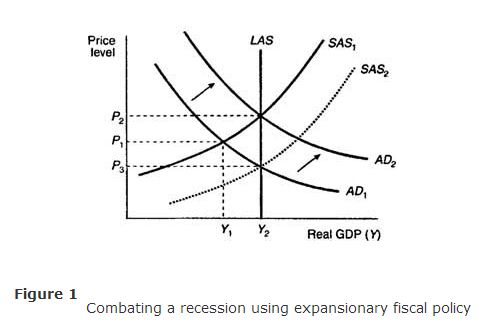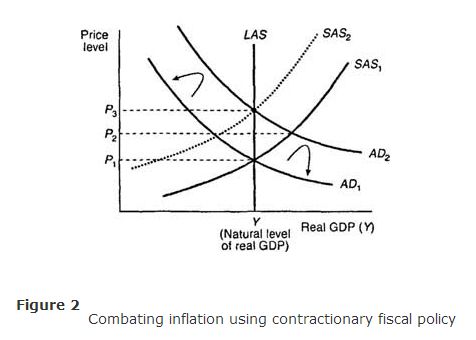Fiscal policy is carried out by the legislative and/or the executive branches of government. The two main instruments of fiscal policy are government expenditures and taxes. The government collects taxes in order to finance expenditures on a number of public goods and services—for example, highways and national defense.
Budget deficits and surpluses. When government expenditures exceed government tax revenues in a given year, the government is running a budget deficit for that year. The budget deficit, which is the difference between government expenditures and tax revenues, is financed by government borrowing; the government issues long‐term, interest‐bearing bonds and uses the proceeds to finance the deficit. The total stock of government bonds and interest payments outstanding, from both the present and the past, is known as the national debt. Thus, when the government finances a deficit by borrowing, it is adding to the national debt. When government expenditures are less than tax revenues in a given year, the government is running a budget surplus for that year. The budget surplus is the difference between tax revenues and government expenditures. The revenues from the budget surplus are typically used to reduce any existing national debt. In the case where government expenditures are exactly equal to tax revenues in a given year, the government is running a balanced budget for that year.
Expansionary and contractionary fiscal policy. Expansionary fiscal policy is defined as an increase in government expenditures and/or a decrease in taxes that causes the government's budget deficit to increase or its budget surplus to decrease. Contractionary fiscal policy is defined as a decrease in government expenditures and/or an increase in taxes that causes the government's budget deficit to decrease or its budget surplus to increase.
Classical and Keynesian views of fiscal policy. The belief that expansionary and contractionary fiscal policies can be used to influence macroeconomic performance is most closely associated with Keynes and his followers. The classical view of expansionary or contractionary fiscal policies is that such policies are unnecessary because there are market mechanisms—for example, the flexible adjustment of prices and wages—which serve to keep the economy at or near the natural level of real GDP at all times. Accordingly, classical economists believe that the government should run a balanced budget each and every year.
Combating a recession using expansionary fiscal policy. Keynesian theories of output and employment were developed in the midst of the Great Depression of the 1930s, when unemployment rates in the U.S. and Europe exceeded 25% and the growth rate of real GDP declined steadily for most of the decade. Keynes and his followers believed that the way to combat the prevailing recessionary climate was not to wait for prices and wages to adjust but to engage in expansionary fiscal policy instead. The Keynesians' argument in favor of expansionary fiscal policy is illustrated in Figure .

Assume that the economy is initially in a recession. The equilibrium level of real GDP, Y 1, lies below the natural level, Y 2, implying that there is less than full employment of the economy's resources. Classical economists believe that the presence of unemployed resources causes wages to fall, reducing costs to suppliers and causing the SAS curve to shift from SAS 1 to SAS 2, thereby restoring the economy to full employment. Keynesians, however, argue that wages are sticky downward and will not adjust quickly enough to reflect the reality of unemployed resources.
Consequently, the recessionary climate may persist for a long time. The way out of this difficulty, according to the Keynesians, is to run a budget deficit by increasing government expenditures in excess of current tax receipts. The increase in government expenditures should be sufficient to cause the aggregate demand curve to shift to the right from AD 1 to AD 2, restoring the economy to the natural level of real GDP. This increase in government expenditures need not, of course, be equal to the difference between Y 1 and Y 2. Recall that any increase in autonomous aggregate expenditures, including government expenditures, has a multiplier effect on aggregate demand. Hence, the government needs only to increase its expenditures by a small amount to cause aggregate demand to increase by the amount necessary to achieve the natural level of real GDP.
Keynesians argue that expansionary fiscal policy provides a quick way out of a recession and is to be preferred to waiting for wages and prices to adjust, which can take a long time. As Keynes once said, “In the long run, we are all dead.”
Combating inflation using contractionary fiscal policy. Keynesians also argue that fiscal policy can be used to combat expected increases in the rate of inflation. Suppose that the economy is already at the natural level of real GDP and that aggregate demand is projected to increase further, which will cause the AD curve in Figure to shift from AD 1 to AD 2.

As real GDP rises above its natural level, prices also rise, prompting an increase in wages and other resource prices and causing the SAS curve to shift from SAS 1 to SAS 2. The end result is inflation of the price level from P 1 to P 3, with no change in real GDP. The government can head off this inflation by engaging in a contractionary fiscal policy designed to reduce aggregate demand by enough to prevent the AD curve from shifting out to AD 2. Again, the government needs only to decrease expenditures or increase taxes by a small amount because of the multiplier effects that such actions will have.
Secondary effects of fiscal policy. Classical economists point out that the Keynesian view of the effectiveness of fiscal policy tends to ignore the secondary effects that fiscal policy can have on credit market conditions. When the government pursues an expansionary fiscal policy, it finances its deficit spending by borrowing funds from the nation's credit market. Assuming that the money supply remains constant, the government's borrowing of funds in the credit market tends to reduce the amount of funds available and thereby drives up interest rates. Higher interest rates, in turn, tend to reduce or “crowd out” aggregate investment expenditures and consumer expenditures that are sensitive to interest rates. Hence, the effectiveness of expansionary fiscal policy in stimulating aggregate demand will be mitigated to some degree by this crowding‐out effect.

The same holds true for contractionary fiscal policies designed to combat expected inflation. If the government reduces its expenditures and thereby reduces its borrowing, the supply of available funds in the credit market increases, causing the interest rate to fall. Aggregate demand increases as the private sector increases its investment and interest‐sensitive consumption expenditures. Hence, contractionary fiscal policy leads to a crowding‐in effect on the part of the private sector. This crowding‐in effect mitigates the effectiveness of the contractionary fiscal policy in counteracting rising aggregate demand and inflationary pressures.
![]()